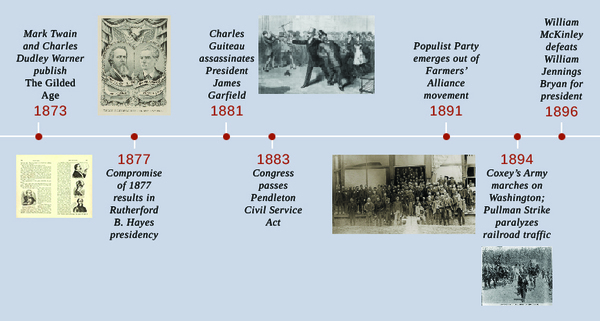| << Chapter < Page | Chapter >> Page > |

The challenges Americans faced in the post-Civil War era extended far beyond the issue of Reconstruction and the challenge of an economy without slavery. Political and social repair of the nation was paramount, as was the correlative question of race relations in the wake of slavery. In addition, farmers faced the task of cultivating arid western soils and selling crops in an increasingly global commodities market, while workers in urban industries suffered long hours and hazardous conditions at stagnant wages.
Farmers, who still composed the largest percentage of the U.S. population, faced mounting debts as agricultural prices spiraled downward. These lower prices were due in large part to the cultivation of more acreage using more productive farming tools and machinery, global market competition, as well as price manipulation by commodity traders, exorbitant railroad freight rates, and costly loans upon which farmers depended. For many, their hard work resulted merely in a continuing decline in prices and even greater debt. These farmers, and others who sought leaders to heal the wounds left from the Civil War, organized in different states, and eventually into a national third-party challenge, only to find that, with the end of Reconstruction, federal political power was stuck in a permanent partisan stalemate, and corruption was widespread at both the state and federal levels.
As the Gilded Age unfolded, presidents had very little power, due in large part to highly contested elections in which relative popular majorities were razor-thin. Two presidents won the Electoral College without a popular majority. Further undermining their efficacy was a Congress comprising mostly politicians operating on the principle of political patronage. Eventually, frustrated by the lack of leadership in Washington, some Americans began to develop their own solutions, including the establishment of new political parties and organizations to directly address the problems they faced. Out of the frustration wrought by war and presidential political impotence, as well as an overwhelming pace of industrial change, farmers and workers formed a new grassroots reform movement that, at the end of the century, was eclipsed by an even larger, mostly middle-class, Progressive movement. These reform efforts did bring about change—but not without a fight.
Mark Twain coined the phrase “Gilded Age” in a book he co-authored with Charles Dudley Warner in 1873, The Gilded Age: A Tale of Today . The book satirized the corruption of post-Civil War society and politics. Indeed, popular excitement over national growth and industrialization only thinly glossed over the stark economic inequalities and various degrees of corruption of the era ( [link] ). Politicians of the time largely catered to business interests in exchange for political support and wealth. Many participated in graft and bribery, often justifying their actions with the excuse that corruption was too widespread for a successful politician to resist. The machine politics of the cities, specifically Tammany Hall in New York, illustrate the kind of corrupt, but effective, local and national politics that dominated the era.

Notification Switch
Would you like to follow the 'U.s. history' conversation and receive update notifications?